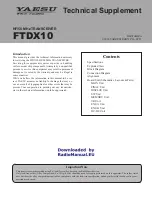
DUPLEX Rx
1
The DUPLEX Rx receiver line is assigned to operate with the transmitter modules DUPLEX Tx in the
2.4GHz band. The fully digital bidirectional communication between transmitter and receiver contributes to
the development of new chances in the model remote control branche.
DUPLEX receivers are not only following up with the JBC receiver line by keeping up their univerzality
and broad functional extent, but they additionally extend these functions due to the feasibility of the new
DUPLEX system. One of the most important advantages is the operation without crystals – watching
frequencies is a thing of the past, high interference resistance, far out of visibility range and continual
control of model conditions in the air as well as many other functions are new and formerly unknown
features.
DUPLEX Rx Receivers:
Basic Data
DUPLEX R4
DUPLEX R5
(R5 indoor)
DUPLEX R6
DUPLEX R8
Dimensions
38 x 20 x 8 mm
44 x 20 x 5 mm
45 x 24 x 12,5mm
50 x 30 x 12,5 mm
Weight
5 g
5 g
(4 g)
11 g
15 g
Antenna Length
2x 100 mm
2x 100 mm
(2x 45 mm)
2x 100 mm
2x 200 mm
Active Part of Antenna
30 mm
30 mm
30 mm
30 mm
# of Channel Outputs
4
5
6
8
Temperature Range
- 10 to + 85° C
- 10 to + 85° C
- 10 to + 85° C
- 10 to + 85° C
Supply Voltage
3,2 – 8,4V
3,2 – 8,4V
3,2 – 8,4V
3,2 – 8,4V
Average Current
39 mA
39 mA
40 mA
48 mA
Real Time Transmission
of Telemetric Data
•
•
•
•
Programming
JETI BOX
JETI BOX
JETI BOX
JETI BOX
Power Output
6 dBm
6 dBm
20 dBm
20 dBm
Receiver Sensitivity
-98 dBm
-98 dBm
-100 dBm
-106 dBm
Supply:
The receiver power supply may be carried out by NiCd cells, by a stabilized voltage from the controller
(in electric models) or by Li-xx cells combined with a voltage stabilizer like the MAX BEC. Always keep in
mind the recommended voltage range of the receiver and the used servos. If all receiver outputs are
engaged you may use an Y-cable for power supply. Supply batteries, BEC or Y-cables may be plugged
into any channel output. Do not use the output marked Ext. for RX-power supply.
Operation:
The DUPLEX system may be operated in the same way as any FM system. We recommend to switch
on the transmitter first and then the receiever. The transmitter confirms switching on of the receiver by a
short beep.
Installation:
Wrap the receiver in soft foam and place it as far as possible away from sources of interference
(servos, power electric motors). The antennas should be routed in such a manner that their active ends
make up an angle of 90° and are as far away as poss ible from each other. See to it that minimum bending
radii of the antenna cables are at least 1cm. The active part of the transmitting antenna should be straight
and far away from metal parts. If the model comprises a carbon fuselage it is advisable to place the active
parts of the antennas outside of the fuselage.



























